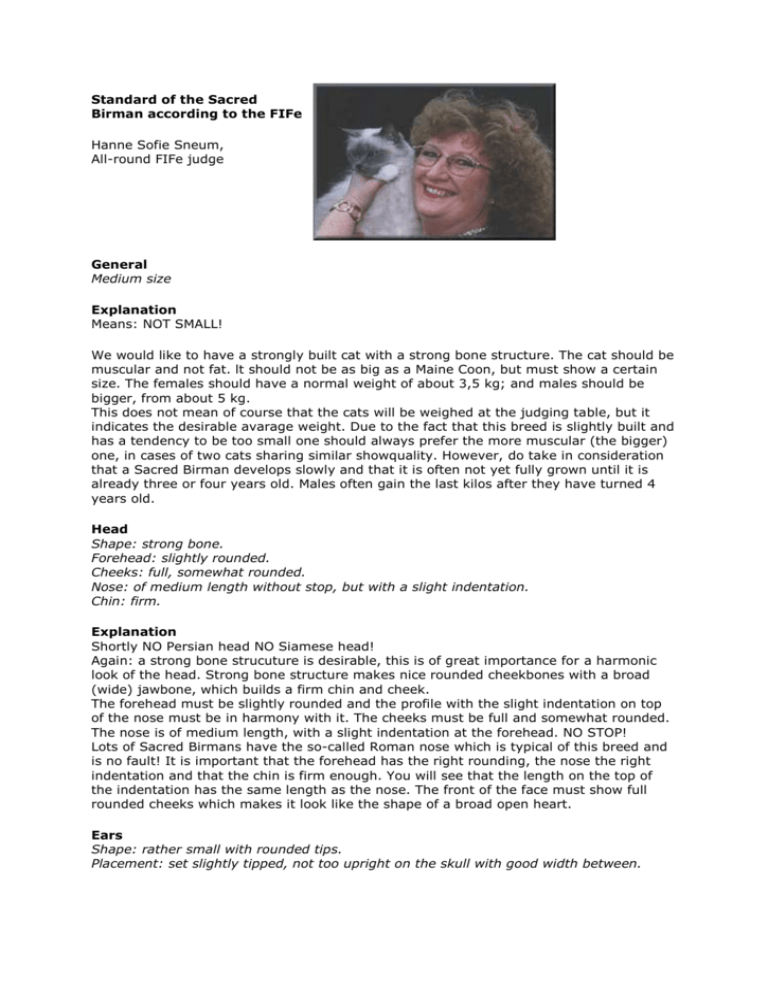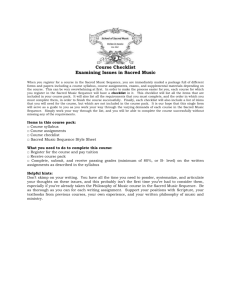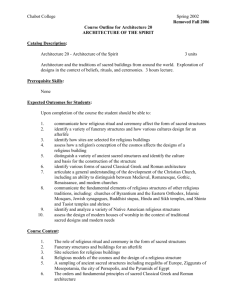Standard of the Sacred Birman according to the FIFe Hanne Sofie
advertisement

Standard of the Sacred Birman according to the FIFe Hanne Sofie Sneum, All-round FIFe judge General Medium size Explanation Means: NOT SMALL! We would like to have a strongly built cat with a strong bone structure. The cat should be muscular and not fat. lt should not be as big as a Maine Coon, but must show a certain size. The females should have a normal weight of about 3,5 kg; and males should be bigger, from about 5 kg. This does not mean of course that the cats will be weighed at the judging table, but it indicates the desirable avarage weight. Due to the fact that this breed is slightly built and has a tendency to be too small one should always prefer the more muscular (the bigger) one, in cases of two cats sharing similar showquality. However, do take in consideration that a Sacred Birman develops slowly and that it is often not yet fully grown until it is already three or four years old. Males often gain the last kilos after they have turned 4 years old. Head Shape: strong bone. Forehead: slightly rounded. Cheeks: full, somewhat rounded. Nose: of medium length without stop, but with a slight indentation. Chin: firm. Explanation Shortly NO Persian head NO Siamese head! Again: a strong bone strucuture is desirable, this is of great importance for a harmonic look of the head. Strong bone structure makes nice rounded cheekbones with a broad (wide) jawbone, which builds a firm chin and cheek. The forehead must be slightly rounded and the profile with the slight indentation on top of the nose must be in harmony with it. The cheeks must be full and somewhat rounded. The nose is of medium length, with a slight indentation at the forehead. NO STOP! Lots of Sacred Birmans have the so-called Roman nose which is typical of this breed and is no fault! It is important that the forehead has the right rounding, the nose the right indentation and that the chin is firm enough. You will see that the length on the top of the indentation has the same length as the nose. The front of the face must show full rounded cheeks which makes it look like the shape of a broad open heart. Ears Shape: rather small with rounded tips. Placement: set slightly tipped, not too upright on the skull with good width between. Explanation To me Sacred Birmans have medium to rather small ears. Birman ears are part of the harmonious general impression of this breed. They are not allowed to be as small as the ears of Persian cats. So again: no Persian ears, no Siamese ears! Younger cats often have very big ears, but if they have a strong bone structure the ears will fit the face once they have grown older. Eyes Shape: not quite round, slightly oval. Colour: deep blue. Explanation Unfortunately, Sacred Birmans often have eyes that are too round or even too almond in shape. The eyes should be placed on a straight line but the outer eye angle should be higher placed than the inner eye angle. The distance between the eyes must be at least one eye width, but a bit more space between the eyes promotes the positive general impression of the cat. The colour of the eyes should be as deep blue as possible, deep blue as in sapphire blue. All kittens are born with blue eyes and then gradually the colour changes. When I wish to see how the eyecolour will develop I watch the eye carefully when the kitten is three weeks old. At this stage I can clearly see the eyecolour it will have later. These are the different varieties of blue you can expect: 1) A kitten with pale blue eyecolour with yellow infiltration, will have a water blue eyecolour as an adult. 2) Pale blue eyecolour with green infiltration, will become medium blue on an adult cat. 3) Siamese blue is exactly the colour we want. Very important: In this breed we have to see to it that the cats are not cross-eyed. Unfortunately there are many SBI cross-eyed; this is often inherited. Sometimes half a litter is born crosseyed, even from excellent lines. Unfortunately with this breed you can only be certain whether the cat is cross-eyed or not when it is already ten months old. So therefore it is of utmost importance not to breed with cats that are cross-eyed or carry this gene. Both breeders and judges should always be alert to face this specific problem. Body Structure: slightly long body; males must be more massive than females. Explanation No Persian body. No Siamese body. The Sacred Birman must have a strong (not too slightly built) body. It is of great importance that the cat is muscular (strongly built) and not 'just fat'. Some kittens are more rounded with babyfat. They tend to become the most muscular adults later. Legs Short and strong. Paws rounded. Explanation To me a Sacred Birman has legs of medium height, not short as a Persian. Gloves The special feature of the Sacred Birman is the white feet called "gloves" on both the front and hind feet. These gloves must be absolutely pure white. They should stop at the articulation or at the transition of toes to metacarpals, over which they should not extend. Slightly longer white gloves on the hind feet can be tolerated. On the back of the hind feet the white gloves end in points. The ideal "gauntlets" ends in inverted "V's" and extend 1/2 to 3/4 of the way up the hock. Lower or higher gauntlets are acceptable but should not go beyond the hock. lt is important that the gloves are equally long and show a symmetry of white, on either the two front or two hind feet, or even better, on all four feet. Explanation With no other breed there is so much discussion about the four white socks and gauntlets as with the Sacred Birman. However, we must be aware that the Sacred Birman consists of more than the four white feet. Of course it is wonderful when you have to deal with a Sacred Birman that has the perfect socks and gauntlets, and of course when you have to choose between two Birmans you have to go for the one that has the best socks and gauntlets. But again: there's more to a Sacred Birman than its socks and gauntlets! If one of the outer toes is not white or the gauntlets are not ending in points, it is not such a bad mistake. It is much worse when there is too much white on the back of the front legs. The borderline on the inside of the front leg lies with the wild claw. White above the wild claw counts as a 'runner' and so is a mistake. The colour of the paw pads can be pink or a mixture with the point colour. They could also have the point colour only! This is not a mistake. You often see that the big paw pad (front feet) is coloured and the back is white; this also is NOT a mistake! Tail Of medium length, forming a plume. Explanation It means NOT SHORT. The tail must match the bodylength and must meet the overall harmony. A long tail is always to prefer to a short tail. Males often have a shorter tail than females and are poorer furnished. Kittens of three months old often have a greyish 'Christmas tree' as a tail. Kittens from over 5 months should -at this age- have a long tail to guarantee it will match the bodylength in the future. A more pale back of the tail of the tabby Sacred Birman does not mean that the cat in question is silver point or carrying silver in its genes; and it is not a mistake! The tailcolour of chocolate and lilac point Sacred Birmans often develops very slowly. Coat Structure: Long to semi-long, According to the actual parts of the body: short on the face, gradually growing longer on the cheeks to a full frill, long on the back and the flanks. Silky texture: Little undercoat. Colour: Shows all characteristics known from the colourpointed cats, but all 4 feet are white (gloves). The points include the face, ears, legs, tail and genitals The point shall be even and in good contrast to the body colour The - and colour of the tummy is a very pale egg shell. The back is golden beige in all varieties Only in adult cats the colour of the points and the body colour is fully developed. Explanation The Sacred Birman is a semi longhair cat. It must have a silky fur texture and most Birmans have little underwool. It means of course that the fur does not become as beautiful on a Sacred Birman as on a Persian cat. Like all semi longhaired cats many Sacred Birmans have a short summerfur and a longer winterfur. The points and furcolour for the solid colours are fully developed after one year (at the earliest), for the diluted colours it can take over a year longer to develop. But in the case of a cat that has glasses around the eyes (lack of colour) and the cat is over two years old, I will give it EX 1 minus certificate owing to its bad condition. The bodycolour should be golden beige to pale beige but here you must allow some differences as older cats often have a darker bodycolour owing to their age. The ideal bodycolour of a Sacred Birman corresponds to the pointcolour meaning golden in all colour variants. A Sacred Birman does not keep its light bodycolour all through its years as a Colourpoint should. Consequently, you must always allow a darker bodycolour on a Sacred Birman. A Sacred Birman with contrasts is always to prefer to a darker cat. Neuters often have a lighter bodycolour than breeding cats. Remarks The Sacred Birman shows a special morphology which is unique for the breed. Explanation This remark gives us a very wide spectrum to work with. The Sacred Birman is one of the oldest breeds. It has kept their characteristics and their special look almost unchanged through all the years; which other breed can claim that? Sacred Birmans have a very special character. Often they make inexperienced stewards nervous with their special way of blowing, they say: 'pt,pt,pt,pt'. This sound indicates it is just a very self-confident cat blowing, and it should not be seen as an act of aggression. Faults Pure white or coloured patches on the chest or belly. Explanation The Sacred Birman is genetically a pointed semi longhaired cat with a bicolour gene. Earlier it was believed that the Sacred Birman had its own white socks gene, and no wonder, if you look at the photos of the old Siamese and Khmers with white socks which were used to breed with. But breeders of Sacred Birmans do try very hard to keep the white bicolour gene on the feet. For instance in South Africa they have changed the standard as they have accepted that it is impossible to breed a seal, blue and tortie/tabby variant completely without spots on the stomach, which I personally find admirable. The white bicolour gene is inherited recessive; it means you can mate two perfect Sacred Birmans together and then get too much or too little white. As we are dealing with a bicolour gene the white is not only visible on the socks and gauntlets. If you have a Sacred Birman with very high socks and gauntlets there will of course be white visible on the lifeline in the middle of the stomach. Again if you have a perfect Sacred Birman without stomach spots, you should choose this, but to me a small spot on the stomach is not a mistake. l just do not want it to be visible on the lower side of the frill as in that case it can be the start of a chin spot or even worse a pink nose mirror. Faults precluding certificate Nose: incompletely pigmented nose leather. Legs: creeping up of the white on the sides or the reverse sides of the gloves of front and/or hind feet (known as "runners"). Absence of "gauntlets" on the hind feet. Coat: white patching in the coloured areas or the revers. A white patch on the genitals. Explanation Very old cats are often seen with lack of colour pigmentation on the nose leather. On lilacpoint it is very difficult to see whether the nose leather is dark lilac or pale lilac/rose. lt should of course be lilac in all shades, but however, the darkest colour is to prefer. It does of course not preclude the certificate. Many Sacred Birmans miss colour pigmentation on the lips which must also be considered as a mistake. Especially the tabbies must have a full coloured line around the lips. Of course it is very difficult if not impossible, to recognise a missing pigmentation on the colours red/cream, tortie and tabby variants because the nose leather here is either without pigmentation and/or spotted. Quite a few Sacred Birman males have a white patch on the top of the genitals. If they have it just there and it does not grow up further on the stomach, I personally do not take it as a mistake. But I do respect my colleagues who do. As a consequence of this many breeders have neutered many a good male which has been a great loss to the Sacred Birman breed as such. But we have to be careful with the spot on the chin. It can be very difficult to see on very young cats in the diluted colours. Conclusion As mentioned before, in the seventies new colours appeared in the breed and it was necessary to mate with other breeds, in order to achieve these colours. Sacred Birmans were mated with long and elegant Siamese and old fashioned Persians with rather long hair. In order to gain the white checking gene, bicolour domestic cats were used too. Unfortunately, the new breeders were not as successful as the old French and German breeders were before and after the Second World War. The new breeders were more interested in the colour than in the type of the Birman. The development of both the Siamese and the Persian type stood miles away from the development of the Sacred Birman. Over the last ten generations, the Siamese turned into a small elegant-typed cat while the undercoat from the Persians became woolier all the time. But as I have mentioned earlier, we do have all the lines needed to make a superb Sacred Birman. Breeders just need the time and the support from each other and not the least from the judges. With open information about what we have and what we want, I am sure we will all have success in the future. First of all we have to consider - both breeders and judges - how we want the future Sacred Birman to look. * Do we want a Persian type Sacred Birman? * Do we want a Siamese type Sacred Birman? * Or do we want a REAL Sacred Birman? I am speaking on behalf of a large worldwide group of experienced breeders and we do, of course, want to maintain the Sacred Birman as the standard prescribes. That is the reason why it has been very sad for many of us to see how overtyped Sacred Birmans have been promoted at shows lately. With 'overtyped' I mean small cats with short noses, a distinct stop, with very long fur and rich underwool. I must say that most of us prefer this breed as it is, in a way, a breed in between breeds in terms of size, fur and type, not to mention that it is very easy to take care of. We would not want to change any of these qualities. This is a huge responsibility for all us and we must be well aware of it. Then we must take into consideration which type we want the Sacred Birman to represent. First of all it is a semi longhaired cat. With all respects it is the cat 'in the middle'; it is not a Persian and it is not a Siamese regarding both type, furquality and size. But it has its own characteristics to be respected and regarded. Taking into consideration all I have mentioned here, I hope to have your support and understanding for the following changes in the standard: * Legs: medium high, strong legs * Head: Roman nose is allowed/convex nose is allowed * Ears: medium big to rather small * Coat: semi long to long. Short season fur is allowed, frill may be missing. We also have to ask the commission in charge to reinsert the colour of the paw pads again. * Paw pads: pink, the point colour or a mixture of both.







